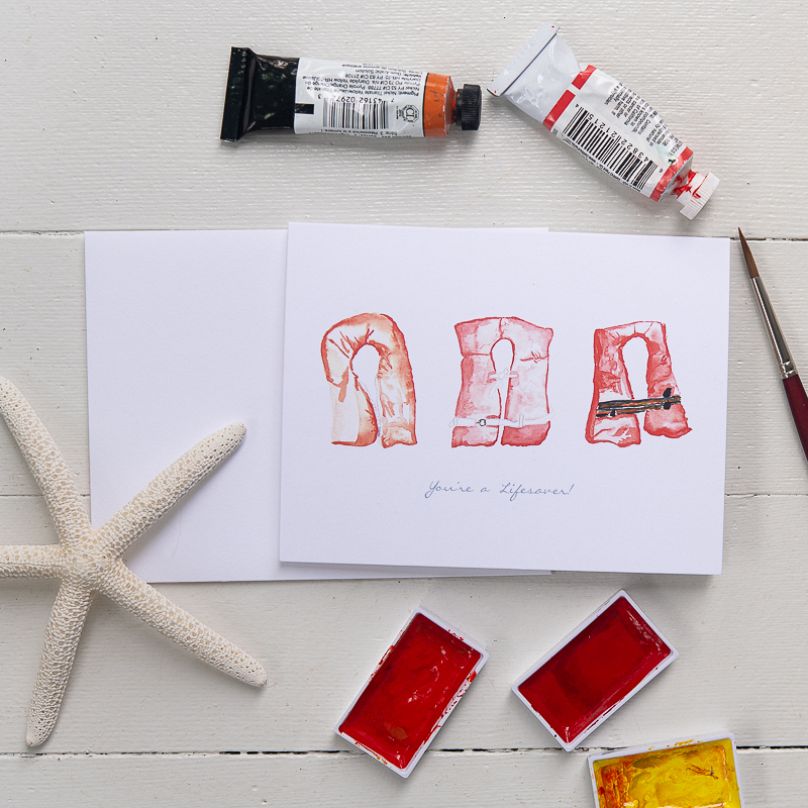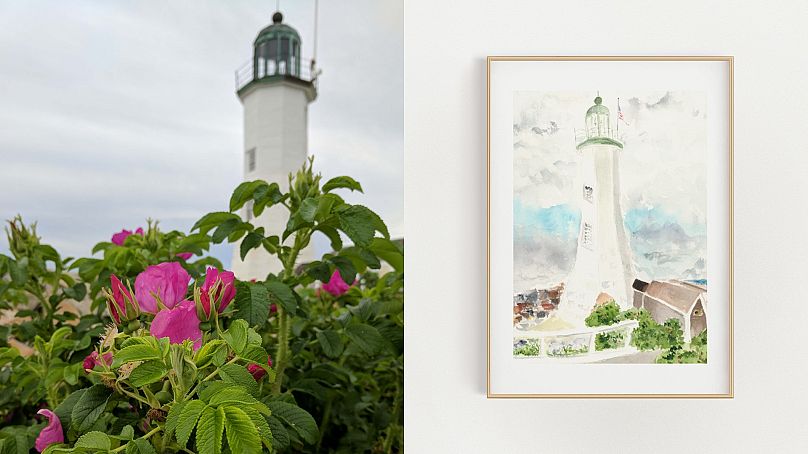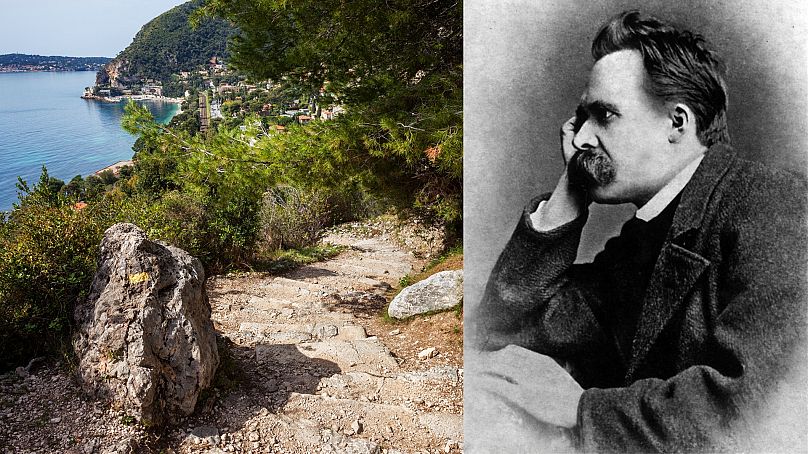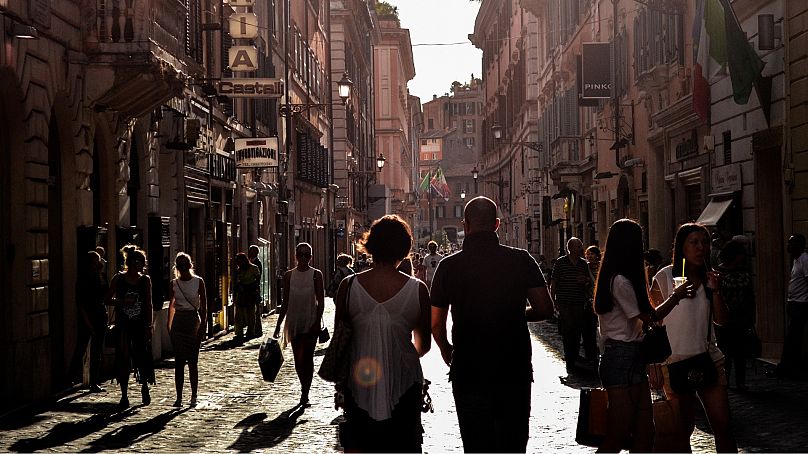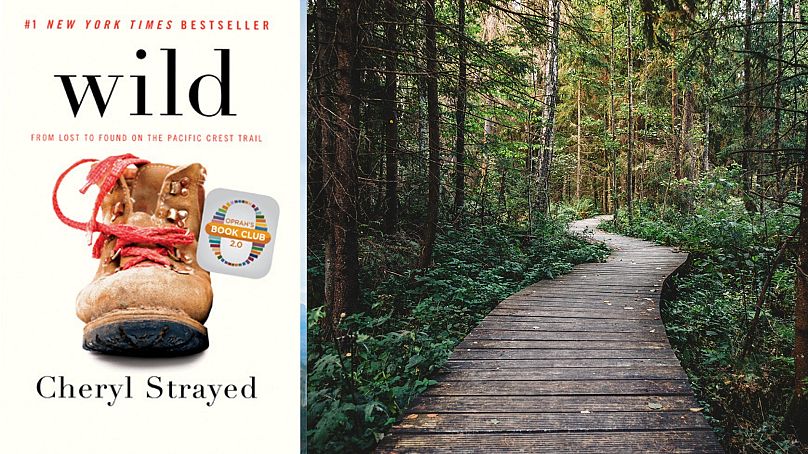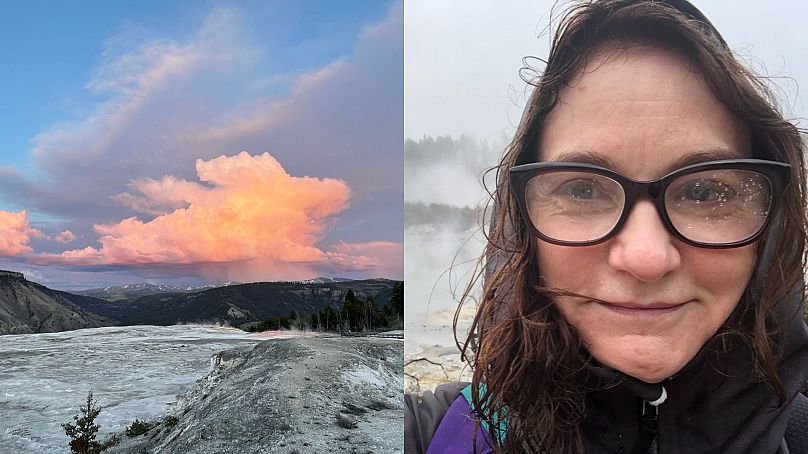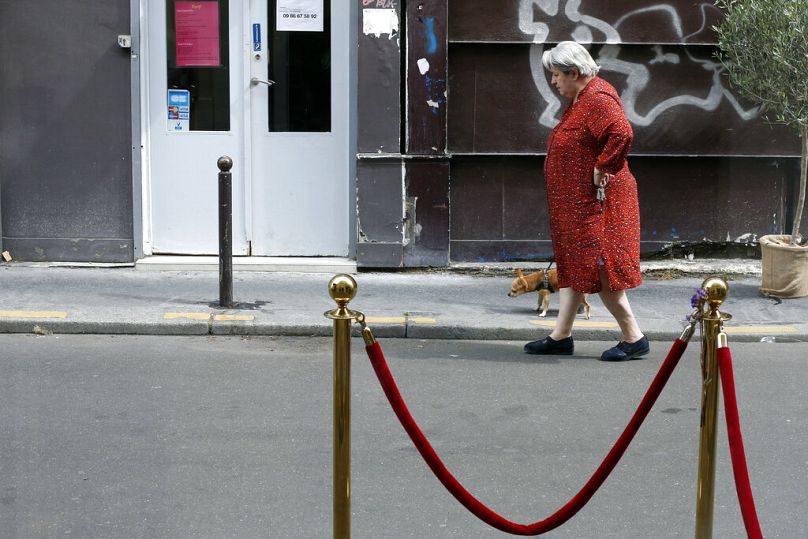Do you want to be more creative? Try taking a walk. We spoke to researchers and avid walkers on how putting one foot in front of the other can be good for the brain. Plus, tips on how to get your step count up.
Walking has long been a source of inspiration for Danielle Driscoll’s artwork and creativity.
The artist and surface pattern designer takes daily hour-long walks with her dogs and husband along the coast where she lives – a small town called Scituate Harbor in the US state of Massachusetts, not far from Boston.
“My artwork is completely inspired by where we live,” she tells Euronews Culture. “The flowers, the nature. I feel like I just feel so much creative energy when I walk and when I’m in the setting that we live in.”
Some of her artwork is directly inspired by what she sees on her walks – like a watercolour she made of some life vests on the town pier, which she turned into a greeting card with the phrase “You’re a lifesaver!” on them, or a painting of a lighthouse she made en plein air.
Other times, Driscoll says walking has had a more subtle effect on her creativity, giving her space away from the actual act of creating so she can approach the task with a more level head.
“Everyday I write my to-do list and I’m like, ahh! I have a million things on my list,” she says. “I feel like going for a walk in the morning takes me out of time, really. It’s almost like yoga, where you get more connected to your inner thoughts. It has a calming factor, but I also feel really energised after I go for a walk.”
Anecdotes like Danielle’s – linking walking to creativity – have been backed up by a growing body of research that proves walking is good not only for our bodies, but also for our minds.
Walking makes us happier and more relaxed, it helps us work through problems and it can even make us think more creatively.
With summer just around the corner, it’s the perfect time to test out the benefits for yourself.
Euronews Culture spoke to avid walkers and researchers on what walking does for the brain – and how to increase your step count this season.
Great minds walk this way
Many of history’s greatest thinkers had one big thing in common – they all enjoyed a good walk.
German philosopher Friedrich Nietzsche was known for taking long, solitary strolls to relieve his migraines. He’d walk up to eight hours every day, jotting down ideas in a notepad as he went along.
He urged people to “sit as little as possible” and “do not believe any idea that was not born in the open air and of free movement.”
Before Nietzsche, Immanuel Kant was so consistent with his daily 3 p.m. walks, which he took to escape the “compulsion of thought,” legend had it you could set your clock by them.
And way before either of them, Aristotle’s Peripatetic School of philosophy was so named for its members' propensity to walk in groups while philosophising.
“It’s been clear since time immemorial that philosophers understood the benefits of going around and walking and talking,” says Irish neuroscientist Shane O’Mara, whose 2019 book “In Praise of Walking” examines the science behind walking.
“So there’s a good question: Can you walk it off? Can you problem-solve by walking? It turns out, actually, you can.”
In the past few decades, numerous studies have shown that walking can help with creative problem solving. But researchers still aren’t sure why.
“We’re still at the beginning,” says Christian Rominger, a researcher in health psychology at the University of Graz in Austria, who has studied the link between walking and creative ideation. “We are still at the point of just showing that there’s an association between physical activity and cognition.”
Even short bursts of walking can boost creativity
Rominger and his colleagues published a study in 2023 called “Step by Step to More Creativity: The number of steps in everyday life is related to creative ideation performance,” which examined the link between walking, mood and creativity.
The study prompted participants at random times of the day using a smartphone app - the two prompts asked them either to come up with as many original uses for an everyday object as possible, or to complete a half-finished drawing in the most creative way they could think of.
The app would automatically measure how many steps the users had taken right before the task and researchers would score the users on how creative their responses were.
“People who are walking more in general, were better in the creative ideation task,” Rominger tells Euronews Culture. “But they were also better in the task when they were when they had more steps directly before the prompt.”
“We found that, for example, doing 500 steps within five minutes will give us an increase in creativity,” he adds.
That means that even people who took fewer steps overall in their day perform better on creative tasks right after a burst of activity.
Research like this is a big reason why writing coach and author Leigh Shulman recommends afternoon walks or physical activity to the aspiring writers she mentors.
“I do feel like knowing that the practical benefits are going to help your work gives people permission to do this thing that just feels like you’re taking a break or being lazy,” she tells Euronews Culture.
“The reality is we really do need it.”
In rural Argentina where she lives, Shulman goes for daily walks in the afternoon to break up her day.
“It revives me and gets me ready to be more focused in the afternoons,” she says.
She recommends that writers and other creatives take a daily lunch break and a short afternoon walk every day to get the creative juices flowing.
“Even if it’s just 15 minutes, go for a walk and see what impact it has on you, on your mental health, on your work,” she says.
Long-distance walking as therapy
Hiking and long, solitary walks through nature have often been a salve for people going through difficult chapters of life.
One of the most famous contemporary examples is found in Cheryl Strayed’s bestselling 2012 memoir “Wild,” which details how the author walked 1,100 miles (1,770 km) on the Pacific Coast Trail to reassess her life after the death of her mother.
The book’s cultural impact was so enormous that the Pacific Crest Trail saw a surge of new hikers and walking groups hit the trail, which they dubbed the “Wild effect.”
The Camino de Santiago in France and Spain is also a testament to the enduring appeal of long walks – established in the ninth century, the network of footpaths is walked by hundreds of thousands of pilgrims every year.
New York City-based writer, actor and filmmaker Lori Hamilton says she often goes on solo walking trips through nature when she needs to recentre herself. She’s been on long walking trips to Greece, Italy, Scotland and New Zealand.
“It's such a powerful experience to go on a long trip and a long hike,” Hamilton tells Euronews Culture. “For me, the first half hour to 45 minutes is chatter, chatter, chatter, chatter, chatter. And I'm thinking about this, or I'm listening to an audiobook…”
“And then you kind of just have to be with yourself. And it really cracks me open as a human being. Something transforms in my life every single time I come back from these trips, and it's never what I expect it to be. Relationships fall away, relationships get strengthened. I always get creative ideas.”
These types of long walks can help contribute to a person’s self-development, according to researcher Martin Mau, PhD, at the University of Southern Denmark, who has published several papers on walking and personal growth.
“Long-distance walking is, to me, about the mental openness; (it’s) a way of walking, where what happens mentally along the way, you don’t know beforehand,” Mau tells Euronews Culture in an email.
According to Mau, one of the major characteristics of a long-distance walking experience is nature, which he calls a “silent partner”. Nature reflects our own thoughts back to us, making it possible to confront issues we may not be aware of in our daily lives.
“Ultimately this may facilitate the process of becoming a person,” he says.
More than that, walking is a rare occasion where we can disconnect from a world where we’re increasingly plugged in, a noisy and hectic place where things move fast and there’s rarely time for reflection.
“(Walking gives you) the chance to be alone, perhaps even outside the range of telephone signal, and do something that is very slow, where the tasks you do are very simple, in an otherwise busy, complicated world!” he explains.
For Hamilton, that disconnection in nature is critical for her creative process.
“I think the thing for me with nature is that it unburdens me from a lot of the sort of societal and personal web of nonsense that goes around me a lot of the time,” she says. “Something about being in nature unburdens me, it opens the pipes.”
The argument for more walkable cities
There are a million ways and places to walk but, according to O’Mara, not all walking is created equal – treadmill walking doesn’t offer the same social benefits as walking outdoors might.
“The key way to think about this really is what benefits does walking confer on you, but also what benefits do you confer on society by walking?” he says.
“What we know is that cities and towns where people walk lots tend to be places where there's high levels of social trust and high levels of social interaction. And this is because you meet people all the time.”
O’Mara says city authorities shoulder a large part of the responsibility for getting people to walk more. Some cities are just not walkable. If that’s the case where you live, you should advocate for change, he says.
“Walking can be a hard thing to do if you're in an environment that doesn't facilitate it, so don't beat yourself up if you're not doing so much walking,” he says. “Instead, what you need to try and do is agitate for change.”
“But even being on a treadmill is better than not doing any activity at all,” he says.
O’Mara, who has an online newsletter exploring the mysteries of the brain, says his goal is to “save walking from being a weekend-only affair for hikers."
For him, that means getting more people walking on a daily basis. While the infrastructure where you live is a big part of walking, O’Mara says there are easy ways to get more steps in each day.
How to get more steps in
1. Get a walking app on your phone
“The very first thing I’d do is put the walking app on your phone,” O’Mara says. “People have no idea how much they walk, and having the walking app on give you a consistent picture of what you’re doing on average, from day to day.”
Apple iPhones have a pedometer in the “Health” app that you can activate to count your steps. Other apps that track your daily step count include Fitbit, Pacer and StepsApp.
Once you have a baseline for how much you normally walk in a day, it’ll be easier to judge how much of an effort you need to make to get more steps in.
2. Sneak in some extra steps
The next big tip to getting your step count up is finding sneaky ways to walk more in your day.
O’Mara suggests getting out a stop or two early if you’re taking public transport to work, so you can walk the rest of the way. If you’re driving, you should try parking further away from the entrance so you can walk a bit before arriving.
“If you take a phone call, always take them walking,” O’Mara says. “You’ll walk maybe 1,800 to 2,000 steps in that half hour without any trouble at all, and you won’t notice you’ve done it. Even if all you’re doing is walking in a figure-eight around the middle of your room.”
3. Set an alarm to get up and move
Another way to get more walking on a daily basis is to set an alarm on your phone or computer to remind you to get up every 30 minutes.
“Just for a minute or two is really good,” O’Mara says. “When you’re standing up, you’re challenging your body in ways that you’re not when you’re seated.”
This tip is especially useful for people with desk jobs, who can often find themselves sitting for hours at a time with back-to-back meetings and tasks.
4. Get a walking buddy
Finally, it’s always easier to stick to a new habit if you have an accountability partner.
“Get a partner in crime and have somebody that you can go for a walk with regularly,” O’Mara says.
Even increasing the amount you walk a little bit can have far-reaching effects, from improving your mood, to helping calm anxiety, to curing a stubborn case of writer’s block.
“What you see when you track people through time is that people who are inactive are much more prone to conditions like major depressive disorder and generalised anxiety,” O’Mara says.
“The interesting thing is that these things are, of course, reversible by engaging in more activity.”

